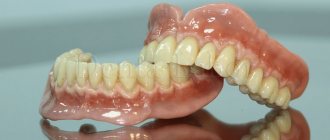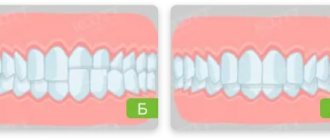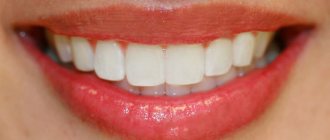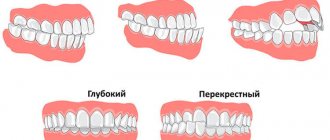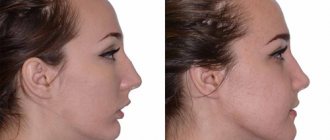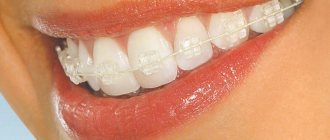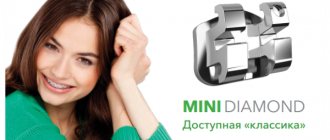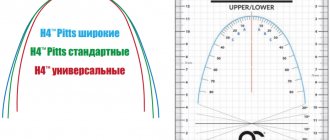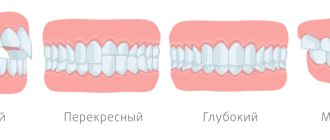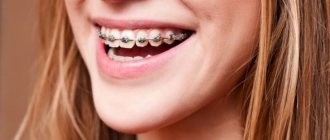Article by speech therapist-psychologist “Dial-Dent” T.B. Zukor
“Chew, chew! Swallow! - a leitmotif familiar to everyone from one of the episodes of the film magazine “Yeralash”. And I’ll tell you about how to swallow correctly, and what you need to do if this process is disrupted. Many will be surprised: is it possible to swallow incorrectly? After all, according to the majority, swallowing refers to reflex reactions of the body, such as breathing, salivation, withdrawing a hand from a hot surface, etc. However, it is possible to swallow incorrectly! This phenomenon is called infantile type of swallowing.
What is infantile type of swallowing?
A child is born with a well-developed swallowing mechanism. Due to the contraction of the muscles of the lips, cheeks, and tongue during sucking, negative pressure is created in the baby’s mouth, and milk enters the mouth, and the tongue, located between the toothless gums, directs the milk into the oropharynx. This type of swallowing is called infantile. Before the first teeth erupt, the infantile type of swallowing is the physiological norm. But as teeth appear, sucking is replaced by chewing, and the infantile type of swallowing is converted to somatic. During somatic swallowing, the tongue is located in the anterior third of the hard palate, while the back of the tongue pushes food into the larynx. Externally, the infantile type of swallowing in children (not infants) and adults is quite distinguishable: with improper swallowing, the tongue is placed between the upper and lower teeth and in the lateral spaces between the teeth. There is another option: during improper swallowing, the tongue does not fit between the teeth, but rests on the lower incisors. The reasons for the infantile type of swallowing are different: prolonged sucking of the pacifier, artificial feeding, short frenulum of the tongue, thumb sucking for a long time, the predominance of liquid puree foods in the child’s diet, mouth breathing, in general, everything that can hold the tongue for a long time at the bottom of the cavity mouth
General overview
The vestibular orthodontic plate is a product made of safe plastic or silicone that the child places in his mouth. It has a fastening that makes the plate look like a regular pacifier. But, unlike pacifiers, the device does not affect the bite and does not prevent the teeth from closing.
The records are produced specifically for children and are supplied in hygienic, convenient packaging. Most kids willingly learn to wear them and exercise with them, because there is a playful aspect to the activities. In addition to its main purpose - getting rid of the pacifier - the vestibular plate can solve a number of other issues of children's health.
Does poor swallowing need to be corrected?
Certainly! Incorrect position of the tongue creates an unfavorable orthodontic situation in the mouth: distal bite, anterior and lateral open bites, underdevelopment of the upper jaw and advanced development of the lower jaw, narrowing of the hard palate, since the tongue ceases to perform a supporting function. Let me make a reservation that the main cause of malocclusion may not necessarily be the tongue. There are also hereditary factors! But, if the orthodontist is faced with an infantile type of swallowing, then it is advisable to send such a patient to a speech therapist to check the working parameters of the tongue. Why is this necessary if the wrong position has become habitual? The fact is that the tongue, as a powerful muscular organ, can “ruin” the work of the orthodontist. This won't happen right away. 1-2, perhaps 3 years will pass, and the new bite created with such great efforts will begin to “creep”. And the reason may be improper functioning of the tongue. The specialists of the orthodontic department of the Family Dentistry have long worked in close cooperation with a speech therapist and receive stable treatment results.
If swallowing is improper, the chewing process also suffers. The patient may experience pain in the TMJ, cervical spine, occipital, temporal and frontal areas of the head.
Indications for use
Whether children need a record should be decided by the doctor at the appointment. Parents need to point out the problem if there is one: the child sucks his finger, chews something, sleeps with his mouth open, etc. After an examination, the doctor recommends the product for use or not - depends on the situation.
Considering that vestibular plates are completely safe, you can safely ask for their appointment. But it is important to use them under the supervision of a specialist: you need to choose the right model, put it on correctly, etc. Errors in wearing can cause a crooked bite.
The main situations when doctors recommend purchasing a record for children :
- the child constantly chews or sucks fingers or foreign objects;
- the baby cannot refuse the pacifier, is capricious, replaces it with his finger;
- there is a habit of sleeping with the mouth open, nasal breathing is poorly developed;
- malocclusions were detected (especially the open type), etc.
How to correct infantile type of swallowing?
A new way of swallowing, also called somatic, will be created by a speech therapist who will prescribe a special set of articulatory gymnastics and training exercises. The complex is selected individually, but there are also exercises common to all (see the list below).
Exercises can and should be done before, during and after orthodontic treatment. It is best to start before installing orthodontic appliances. If the case is simple, then the exercises are performed for 10-15 minutes daily for 1.5-2 months. During scheduled classes, the speech therapist corrects the technique of performing exercises, introduces additional exercises into the complex to consolidate the necessary skills, and massages the tongue.
Sizes and types. What are they made of?
Most plates are made either from food-safe plastic, which provides a rigid frame, or from soft silicone. The choice of material depends on the doctor's decision. Children's plates are made in two sizes:
- first (I) for children with primary malocclusion. Its radius is 22.5 mm. The product can be distinguished by the characteristic red color of the ring;
- the second (II) for children with mixed dentition. Its radius is 30 mm. She has a dark blue ring.
There are several varieties of vestibular plates . All of them appeared later than the standard one and, in addition to the development of nasal breathing, help to cope with the problems of a “flaccid” tongue, eliminate speech defects, correct swallowing, etc. The three most popular models are: classic, with a bead, with a flap and with a visor.
Model with visor
The visor appeared on vestibular orthodontic plates when doctors realized that it was difficult for children with underdeveloped jaws and protrusion of the upper frontal teeth to hold the classic model in their mouth. For them, it constantly deviated above the sagittal protrusion, and at night it completely fell out. The presence of a visor solves this problem.
The vestibular plate with a soft or hard visor is ideal for the treatment of all class II abnormalities. It also stops the development of class III anomalies if worn with the visor up. Due to the fact that the product pushes the upper jaw forward, wearing it normalizes the position of the jaws relative to each other.
Model with damper
The tongue deflector plate is designed for those children who are accustomed to placing their tongue between their teeth when swallowing and speaking. This habit interferes with the normal growth of teeth and leads to the formation of an “open” bite. The flap pushes the tongue back and forces it into the correct position.
In addition, a vestibular plate with a tongue flap helps:
- eliminate the habit of breathing through your mouth;
- teach the child to correctly position the tongue in the mouth during speech;
- strengthen the circular muscle of the tongue, normalize lip closure.
Because the model is often used with speech therapists to demonstrate proper tongue placement, it is made transparent.
Model with bead
The vestibular bead plate is used primarily to correct speech problems. It helps stimulate “flaccid tongue” in children with speech impediments. The standard plate itself aligns the position of the tongue, teeth, lips, helping to improve diction, and an additional design element enhances the effect.
There are two models of bead plate :
- classical. It has an extended bead that stimulates the root of the tongue. This model helps with dysarthria, increased muscle tone, impaired pronunciation of hard and soft consonants, rhinolalia, tachylalia, as well as in the treatment of stuttering. It helps to train weakened tongue muscles;
- new model. Her bead is moved closer to the plastic base and teeth. This model of plate is recommended for children with reduced tone of the tip of the tongue, various forms of sigmatism, lambdacism, and problems with the pronunciation of the “r” sound.
If for some reason a parent wants to buy a record without a doctor’s recommendation, it is advisable to purchase a standard model. It is universal, easy to use, and there is no negative effect when using it. All specialized models - with a bead, a visor, a flap - must be purchased exclusively on the recommendation of a doctor.
Use for malocclusion in children
Often, plates are prescribed to young children when their malocclusion has already formed. There are indications for this: the product is not effective in all cases. Since plates are primarily preventive devices, they cannot cope with very severe disorders.
Plates can affect teeth that have either protruded forward, are not very straight, or can be corrected by influencing other elements in the dentition. If a child experiences incorrect eruption (the tooth has grown in the palate, is turned incorrectly, etc.), this cannot be corrected with plates. That is why these orthodontic products are used primarily for early treatment of malocclusion. At 6-7 years old, the orthodontist recommends trainers that have a wider range of capabilities.
Read more about trainers and treatment with their help in our article: “Trainers for straightening teeth: description, varieties, tips for use.”
Advantages and disadvantages
Vestibular plates are prescribed to children quite often because they are very effective and have almost no contraindications. The advantages of records are:
- ease of use and maintenance;
- need to be worn overnight and for several hours during the day (does not require use all the time like braces);
- low cost;
- training in a playful way;
- possibility of use from an early age;
- presence of other effects (strengthening speech organs, etc.)
The disadvantages include, first of all, a narrow range of influences. Plates cannot cope with all problems. Also, due to the ability to remove the product, the treatment time is extended.
What is myogymnastics?
Myogymnastics is a special exercise for the muscles of the oral cavity. Special sets of exercises develop and strengthen certain muscles of the dental system and, due to this, have a therapeutic effect. Myogymnastics is intended both to prevent the development of malocclusion and speech defects, and to eliminate existing problems.
The myogymnastics complex can be prescribed as:
- self-sufficient treatment in itself,
- as a preliminary stage of treatment,
- simultaneously in combination with other methods of orthodontic treatment. For example, along with wearing orthodontic devices - mouth guards and plates.
What exercises to include in the complex, how and when to do them - only the doctor decides. It makes no sense to independently prescribe a myogymnastics complex to a child at home - it will not give any effect.
But, if the orthodontist prescribed myogymnastics, it must be done; the exercises will shorten and facilitate the main treatment.
The main thing is to carry them out, following several rules:
- Myogymnastics in the primary occlusion is most effective with children 4-7 years old - at this age the child already understands well what is required of him.
- You need to do myogymnastics with your child regularly, at home on your own or in the orthodontist’s office.
- For the complex to produce results, you need to perform a specified number of repetitions of each exercise.
- Muscles must work at full strength, but within the limits of the child’s physical capabilities.
At the GALA DENT clinic on Prosvet we use this physiological method of treatment when working with children.
Bite problems begin in early childhood
The health of first the child and then the adult depends on the attention and care of parents.
But often parents do not pay attention to how the first teeth grow; anyway, they will fall out and there will be new ones. They believe that it is normal not to treat even caries and pulpitis, let alone crooked teeth, their uneven location in the jaw, a frenulum that is too large or, conversely, too small. It seems to them that all children suck their thumbs or constantly breathe through their mouths. Parents do not see such “little things” as a problem. They think that it is too early, and after replacing the teeth with permanent ones, everything will return to normal on its own. So why waste money and torture a child? Unfortunately, with the formation of a permanent bite, all milk problems do not go away, but, on the contrary, begin to actively worsen. A person enters adult life with an ugly smile, an incorrect bite and, often, with deformation of facial proportions. And this is only the visible part of the troubles; problems with bite affect the entire human body. Read more about this in our article on adult orthodontics.
On this page you will learn everything parents need to know so that their child has a healthy bite and straight teeth.
Advantages of MC "Veramed" in the treatment of pharyngeal neurosis
At the Veramed clinic in St. Petersburg, patients are provided with high-quality treatment of pharyngeal neurosis thanks to the following advantages:
MC "VERAMED" uses treatment methods that affect the cause of the disease - hypnotherapy, reflexology.
Pharyngeal neurosis is a psychosomatic disease, therefore, after working through emotional problems in hypnosis, complete recovery occurs. Drug therapy affects symptoms and does not provide cure; it can be used as an adjunct.
Lump, burning and other sensations in the throat are a manifestation of “emotional scars” in the body, and our hypnotherapy technique is based on processing these sensations.
Diagnostic methods
- Detailed questioning about complaints, medical history and life history, thorough examination.
- Laboratory tests (general and biochemical blood tests, thyroid hormones).
- X-ray of the head, lungs, throat, MRI and CT scan of the throat.
- Ultrasound Dopplerography of the vessels of the brain and neck.
- Electromyographic study.
Diagnosis of pharyngeal neurosis is quite complex, and treatment can only begin after completely ruling out other diseases with similar symptoms.
Symptoms of pharyngeal neurosis
- Specific:
- lump in throat, dryness;
- soreness, burning sensation in the throat;
- a sore throat;
- spasm, feeling of constriction in the throat;
- itching in the nasopharynx;
- numbness of the throat;
- strengthening of the pharyngeal reflex;
- swallowing disorder;
- hoarseness or complete aphonia.
- Non-specific:
- headache, worse when swallowing;
- irritability;
- insomnia;
- sweating;
- heartbeat;
- memory impairment;
- loss of appetite;
- enuresis, stuttering in children, in addition to unpleasant sensations in the throat when excited.
Treatment with devices
The vestibular plate is primarily a therapeutic orthodontic device. It must be worn in accordance with the recommendations of doctors. Treatment can begin at 3 years of age, when the baby’s primary dentition is partially formed. Also, the plate can be worn throughout the entire mixed dentition. On a permanent bite, the device no longer has any effect.
Do not forget that there is a vestibular plate for the primary and secondary occlusions.
Forms or types of pharyngeal neurosis
- Anesthesia most often appears during hysterical reactions and is manifested by a feeling of lack of air and problems with swallowing, up to the inability to swallow food.
- The main manifestation of hypoesthesia is the feeling of a lump in the throat.
- Hyperalgia – pain is felt in the throat area, which intensifies when eating.
- Hyperesthesia - a burning sensation or lump in the throat that cannot be swallowed, problems with swallowing.
- Parasthesia is numbness, lump, sore throat and other sensations that constantly change.
